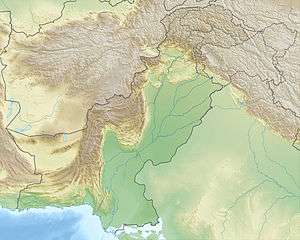Lal Suhanra National Park
Lal Suhanra is a national park in Pakistan that is situated in the Bahawalpur district of Punjab province. It is one of South Asia's largest nationals parks, and is a UNESCO declared Biosphere Reserve.[1] Lal Sohanra is notable for the diversity of its landscape, which includes desert, forest and wetland ecosystems.[2]
| Lal Suhanra National Park لال سہانرا نیشنل پارک | |
|---|---|
 Lal Suhanra National Park Location in Pakistan | |
| Location | Punjab, Pakistan |
| Nearest city | Bahawalpur, Pakistan |
| Coordinates | 29°19′N 71°55′E |
| Area | 65,791 ha |
| Established | 1972 |
Geography and wildlife
The park itself is situated some 35 kilometres east of Bahawalpur and presents a synthesis of forest and desert life. It occupies land on both sides of Desert Branch canal, and is spread over an area of 127,480 acres (51,368 hectares) - out of which 20,974 acres (8,491 hectares) are green land (irrigated plantations), 101,726 acres (40,942 hectares) are dry land (desert), and 4,780 acres are wet land (ponds and lakes). The park's terrain is generally flat, interspersed with sand dunes measuring between 1 and 6 meters in height and occupying as many as thousands of acres apiece.[3]
The biosphere reserve is crossed by the dried-up bed of the Ghaggar-Hakra River and comprises Patisar Lake and irrigated land. Officials said that indigenous trees like Indian rosewood and Acacia karroo will be planted over 1,212 acres of barren land in the wildlife reserve.[4]
Many species of animals can be found throughout the park. These include several wild animals of the desert such as Asiatic wildcats, rabbits, bustards, and deer. Reptiles in the park include the monitor lizard, Russell's viper, Indian cobra, saw-scaled viper, wolf snake, John's sand boa, and spiny-tailed lizard. More than 160 species of birds are also present, including the houbara bustard, griffon vulture, crested honey buzzard, marsh harrier, hen harrier, laggar falcon, peregrine falcon, kestrel, Eurasian sparrowhawk, Egyptian vulture, lark, shrike, wheatear, and barn owl. Lake Patisar, a large body of water in the center of the park, is ideal for bird watching. In mid-winter, the lake is regularly home to between 10,000 and 30,000 ducks and common coot.
Attractions
The Punjab government has plans to convert the Lal Sohanra National Park into a wildlife safari park of international standard. One of its most prominent attractions is currently the lion safari, which allows guests to see lions in their natural habitat at close range. In addition, the park's captive breeding suite holds a pair of Indian rhinoceros which were given by Nepal.[5] Rhinos were once found as far west as the Peshawar Valley during the reign of Mughal Emperor Babur, but are now extinct in Pakistan.
Over 400 animals are currently being bred in the Lal Sohanra Park, including a large population of blackbucks, a breed of antelope most notable for its pronounced sexual dimorphism. The park is constantly supplied with new blackbucks in order to extend its efforts toward blackbuck conservation.
There are archaeological remains of an ancient civilization which once flourished along the Ghaggar-Hakra River.
References
- "Lal Suhanra". UNESCO. Retrieved 28 December 2016.
- "Lal Suhanra National Park". Forest, Wildlife and Fisheries Department, Punjab. Retrieved 28 December 2016.
- "Lal Suhanra National Park". Forest, Wildlife and Fisheries Department, Punjab. Retrieved 28 December 2016.
- Abdul Manan (February 18, 2016). "PM Nawaz returns to old haunt to enjoy desert skies, music and milk". The Express Tribune. Retrieved 28 December 2016.
- "Pakistan hopes Nepali rhinos will breed, multiply". SOS Rhino. Retrieved 28 December 2016.
External links